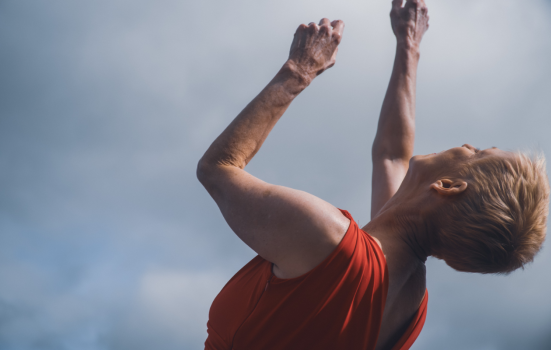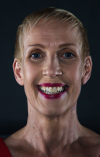What is it like to perform as an older woman in an industry obsessed with youth? Sandy Cuthbert shares her experience of returning to the stage with ‘Epilogue’.

Conan McIvor
The American dancer and choreographer Martha Graham famously said: “A dancer dies twice — once when they stop dancing, and this first death is the more painful”. I had not danced professionally for over twenty years so to commit seriously to the process of rehearsals and performing again, it had to be the right project.
Older women dancing is not prevalent and opportunities to be involved in a professional project are rare. When choreographer Eileen McClory approached Jane Mooney and me (both now in our sixties) to embark on a project inspired by the Graham quote, I could not resist the opportunity of exploring the themes it presented.
We began the research phase of Epilogue in summer 2020 and, with commission and production support from Maiden Voyage Dance, the piece has been brought to fruition this year as part of Belfast International Arts Festival. It has been a true collaboration between choreographer, dancers, poet, filmmaker and composer. Deep listening and measured response has been central to the creation process along with trust, belief, and vision carefully nurtured within a non-judgmental setting.
Celebrating the lived-in body
Coming back to professional dance after a break of several years you are filled with self-doubt and anxiety about your capacity as a dancer. You may not have the same energy levels, athleticism and youthful exuberance of your former self, but you have a wealth of knowledge and experience from life to draw upon as a dancer: wisdom, grounding, sensitivity, emotional maturity, resilience. What you can bring to the table is an openness, an honesty, an authenticity that was possibly not so present in your earlier years.
For Jane and me, as mature dancers, it has been a very rewarding process as the themes and ideas have been developed around our personal experience. Our authentic physical, mental and emotional life journey have been most revealing, life-affirming and powerful. The choreographer has built movement material sensitively with us as dancers, regarding the project as an opportunity to celebrate the lived-in body, rather than make it try to copy what we were in our youth.
“You’re too old to train”
Coming to this project I had over forty years in the dance industry to draw on. When at 17 I retired as a national gymnast and participated in my first contemporary dance class, I knew immediately that I wanted to pursue a career as a professional dancer.
I completed a Creative Arts BA (Hons), PGCE, post-graduate training at London Contemporary Dance School and MA in Dance and Somatic Well-being. I have worked as a commercial dancer, a circus performer, as a contemporary dancer for Diversions-National Dance Company of Wales, and In Transit.
In my life I have encountered some setbacks in the industry, including ageism. Both Jane and I came to conservatoire dance training in our mid-twenties and had to fight due to the attitude “you’re too old to train”. As an educator I have very much supported the mature dance student; many of my past mature students in Northern Ireland are now very successful dance practitioners.
Women dancing professionally in their late thirties and forties begin to be devalued over more youthful dancers within the company system. Due to the economic downturn, the companies that were built around the more mature experienced dancer are now few and far between.
The transformative power of dance
Many dance courses across the UK are closing due to lack of funding, including those in Belfast where I taught. And the MA in Dance and Somatic Well-being at UCLAN is closing this year - is it a coincidence that most students on this course are mature women?
Contemporary dance growth is being severely curtailed due to education and arts funding cuts and the added effect of Brexit on the industry, which in turn makes it even more devastating for any mature dancer to have agency within this climate.
Personally and professionally, I have experienced how transformative dance can be for the older female dancer. The Belfast Movement Choir, one of the community projects that I have been developing with Maiden Voyage Dance, demonstrates this: many older women participants have found the experience life affirming and liberating.
As an industry we need to keep lobbying for the positive aspects of dance for older people on their health and well-being - now more than ever with the effects of Covid on people’s physical and mental health.
Older bodies can express renewal
As the choreographer of Epilogue Eileen McClory says, older women are no longer valued as vibrant. They are diminished by loss of fertility, negative views of the menopause and lack of perceived sexuality. They are reduced and increasingly invisible.
Older women can be marginalised in the dance world, but there is no reason that we should stop seeing them perform on stage. The dancers “are not playing at illustrating lived experience, they have it in their bones, along with years of invaluable experience and stagecraft”.
Epilogue is about witnessing the lived experience of the mature female body. That has significance, a body that should be seen and celebrated and a voice that should be heard. It is the potential of older bodies to express and embrace a sense of renewal.
The experience of Epilogue has been moving and inspiring for audiences, particularly an older female audience who have found it has particular resonance to their own lives. Our hope is that the planned film installation will further engage people in conversation on ageism and sexism within dance, the arts and beyond.
Sandy Cuthbert is a freelance dance and somatic practitioner based in Belfast.




